The resort is unique in the sense that it has been blessed with some of the most captivating landscape and Gothic architecture in the world, never mind the theme park industry. The view from Towers Street easily rivals and tops the majority of views when entering other theme parks across the globe, even favourably comparing with the vistas of the various Disney sites. Whilst the ruins play a crucial part in the theme park’s structure as the true mascot and image of Alton Towers, the Gardens are far too frequently overlooked by the majority of regular and irregular guests.
Ultimately, it falls down to the fact that Alton Towers is a theme park; the rides are the main purpose for the majority of guests to visit. However, that doesn’t prevent anyone from spending a few moments or several hours of their day strolling through the unique, vast and colourful labyrinth of the Alton Towers Gardens. So whether you’ve never had the opportunity to venture down into them, or you’re a hardened Gardens veteran who’s simply missing the tranquillity of its environment, allow me to take you on a virtual journey into the depths of where the magic lies.
Due to the prodigious scale of the Gardens, there are no shortage of entry and exit points located around the theme park, permitting relatively easy access should you wish to have a leisurely stroll at any point during your day. The Gardens are perhaps best viewed from the pathway that takes guests from the Towers over to Mutiny Bay, allowing a gorgeous scope of view that gives an insightful and encouraging glimpse to guests, enticing them in to the colourful and historic labyrinth. With that in mind, we shall begin our tour from this very walkway, descending down to our first stop of the tour, the Italian Garden.
The Choragic Monument
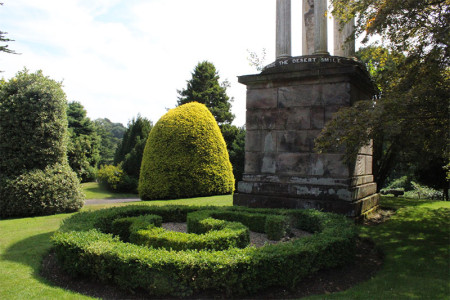 Within the Italian Garden is one of the most iconic sights in the Gardens; the ‘Choragic Monument’, a structure erected in memory of Charles Talbot, the 15th Earl of Shrewsbury.
Within the Italian Garden is one of the most iconic sights in the Gardens; the ‘Choragic Monument’, a structure erected in memory of Charles Talbot, the 15th Earl of Shrewsbury.
The monument itself is a replica of the famous Choragic Temple of Lysiscrates from Athens, which dates back to 833 BC. With such a close proximity to one of the major entry points into the Gardens, it’s almost guaranteed that every single guest who enters the theme park will catch a glimpse of the monument during their day.
The structure contains a marble bust of the Earl, as well as the words ‘He Made The Desert Smile’ engraved into the monument. The words stand as tribute to the Earl’s vision of transforming what was originally a vast and blank landscape, into an eccentric and yet somewhat original one. Situated directly in front of the monument is a bespoke letter S, carved intricately out of shrubbery.
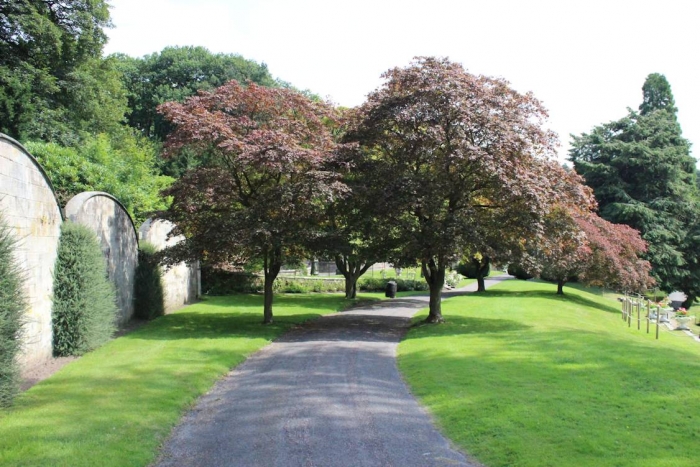 One of the many pathways that entices you further into the Gardens
One of the many pathways that entices you further into the Gardens
The Talbot Hound Fountain
As we proceed downwards into the Gardens, we are greeted on the left by a wall embedded with a rather unique fountain, made from stone and resembling the shape of a Talbot Hound’s head. This particular fountain is just one of the unique and meticulously thought out details that makes the Gardens so unique.
The Dutch Garden
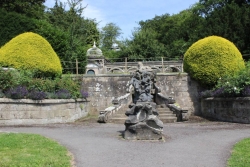 Up ahead lies the picturesque Dutch Garden, perched perfectly in front of a structure known as the Orangery.
Up ahead lies the picturesque Dutch Garden, perched perfectly in front of a structure known as the Orangery.
The contents of the Dutch Garden is almost completely symmetrical, with the exception of the unconventionally shaped shrubbery placement.
The Orangery
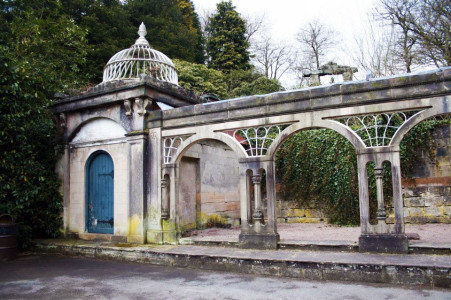 Two sets of steps either side of the area will guide us up to the Orangery, one of the structures that has sadly seen better days. The Orangery was originally erected in the 1820’s, also known as the ‘Quarry Greenhouse’. It features two end bays that were each topped by a decorative dome. As the Gardens have stood the test of time, one of the domes unfortunately has not, and only the West bay upholds the remains of one of these domes.
Two sets of steps either side of the area will guide us up to the Orangery, one of the structures that has sadly seen better days. The Orangery was originally erected in the 1820’s, also known as the ‘Quarry Greenhouse’. It features two end bays that were each topped by a decorative dome. As the Gardens have stood the test of time, one of the domes unfortunately has not, and only the West bay upholds the remains of one of these domes.
A series of Gothic arches connect each of the bays, formerly standing over a glass panelled frontage. The glass panels have long since become a piece of removed history, and the inside contents of the structure have been bricked over. Despite succumbing to dilapidation, the Orangery still offers a breath taking view over the Dutch Garden and out into the valley.
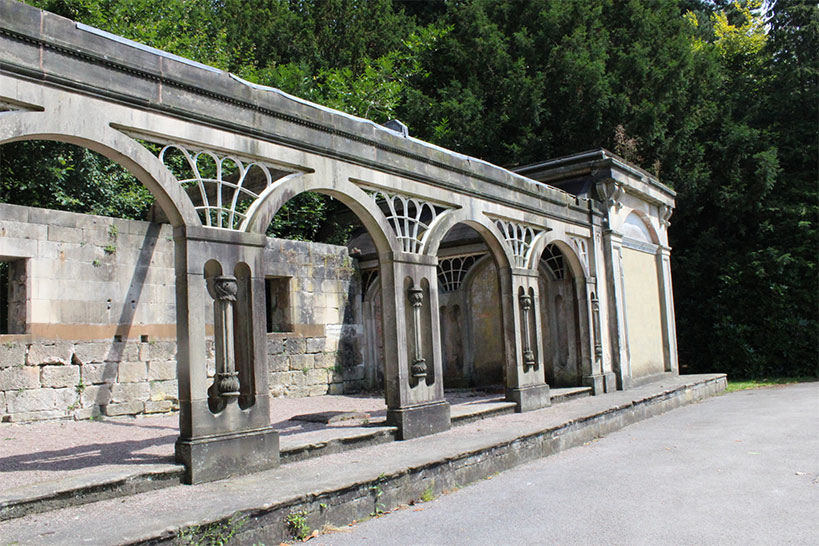 The domeless wing of the Orangery
The domeless wing of the Orangery
Perched neatly behind the Orangery and Dutch Garden is a Grade II listed formation of stones, sharing the same name as its globally recognised counterpart, Stonehenge.
The Conservatories
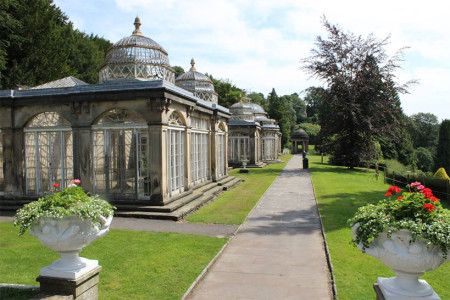 Following the path further to the East, we are greeted by the Conservatories. Last restored in the 90’s, they were originally designed by Robert Abraham and constructed in 1824. The main structure is made of cast-iron which runs along the entire length of the single storey structure. The roof is occupied by seven glazed domes of which, the centre one is considerably larger than the rest. These domes have fared much better over the years than those on the Orangery.
Following the path further to the East, we are greeted by the Conservatories. Last restored in the 90’s, they were originally designed by Robert Abraham and constructed in 1824. The main structure is made of cast-iron which runs along the entire length of the single storey structure. The roof is occupied by seven glazed domes of which, the centre one is considerably larger than the rest. These domes have fared much better over the years than those on the Orangery.
The Conservatories have become one of the most iconic and recognised elements of the Gardens, being visible from various angles across the theme park. They are particularly noticeable from the Skyride, dominating the Northern sector of the Gardens and looking down over the rest of the exquisite landscape.
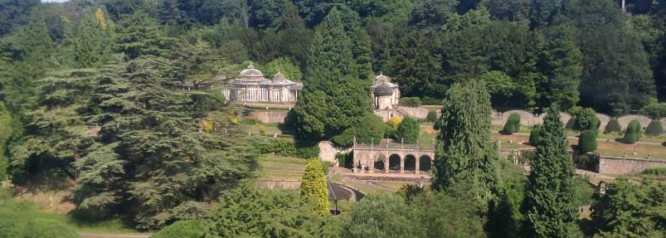 The Conservatories visible from the Skyride.
The Conservatories visible from the Skyride.
The Conservatories’ restoration in the 90’s led to them becoming a major supporting pillar in the marketing for the park at the time. Whilst they still remain one of the most exemplary structures in the Gardens, the signs of decay and yielding to nature are largely visible. The central atrium features a tree that has over time, grown to such an extensive degree that it has become incorporated into the architecture.
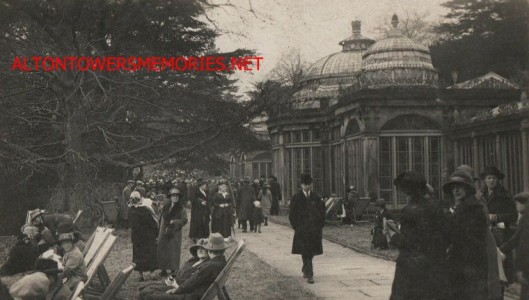 The Conservatories hosted several grand events in the 20th century, before becoming the location for various tea shops and pottery studios. The state of deterioration that they have sorrowfully fallen into however now prohibit the public from being able to gain access into their interior. Despite this, we are still able to view the innermost area of the Conservatories, courtesy of the modern glass windows that have been integrated into the structure.
The Conservatories hosted several grand events in the 20th century, before becoming the location for various tea shops and pottery studios. The state of deterioration that they have sorrowfully fallen into however now prohibit the public from being able to gain access into their interior. Despite this, we are still able to view the innermost area of the Conservatories, courtesy of the modern glass windows that have been integrated into the structure.
The Summerhouse
Proceeding further to the east, we encounter this grand Grade II listed stone summer house. The small shaded interior of the summerhouse is accessible, offering an intimate spot to get away from the radiant rays of sunshine that, in the summer, truly allow the Garden to blossom in its fullest and most vibrant display. This structure which is one of the many in the Gardens that originates from the 19th century, also offers a second hideaway to truly allow you to escape from the hustle and bustle of the theme park that by now, you may have forgotten is still all around you.
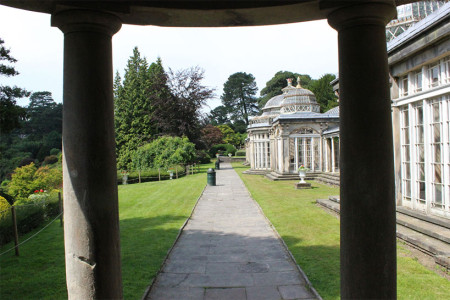 The pathway down the front of the Conservatories, viewed from atop the summerhouse.
The pathway down the front of the Conservatories, viewed from atop the summerhouse.
Proceeding down the steps to the side of the summerhouse, we encounter a secluded spot known as ‘The Grotto’. This petite rocky alcove faces Eastwards, the direction we shall continue to travel in whilst also offering a marvellous view of the bizarre spectacle that lies ahead of us.
Yew Walk
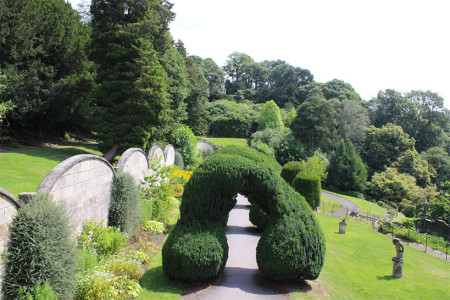 The quirky nature of the Gardens is irrefutably strengthened as we progress further into the east of the them. These oddly shaped yew arches (known as the ‘Yew Walk’) are perhaps the most iconic non-architectural element within this valley of lavish colours. They play true to the Earl’s original vision of creating a garden full of immersive and stunning visuals that evoke enchanted fairy tale locations and further make-believe folklore. To our left, you can also see the consistency of a lobed wall which separates the multiple tiers that the Gardens are based across and upon, whilst on the opposite side our view has drastically changed compared to when we first entered the Gardens, as we continue to descend deeper.
The quirky nature of the Gardens is irrefutably strengthened as we progress further into the east of the them. These oddly shaped yew arches (known as the ‘Yew Walk’) are perhaps the most iconic non-architectural element within this valley of lavish colours. They play true to the Earl’s original vision of creating a garden full of immersive and stunning visuals that evoke enchanted fairy tale locations and further make-believe folklore. To our left, you can also see the consistency of a lobed wall which separates the multiple tiers that the Gardens are based across and upon, whilst on the opposite side our view has drastically changed compared to when we first entered the Gardens, as we continue to descend deeper.
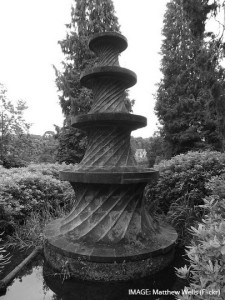 The Corkscrew Fountain
The Corkscrew Fountain
Our next point of interest on the tour is the rather unusual Corkscrew Fountain. This intricately carved stone fountain also goes by the name of the ‘Siren Fountain’, or the better known ‘Candlestick Fountain’. Another piece of architecture bestowed with a Grade II listing, the Corkscrew fountain consists of four tiers that slowly shrink on each ascending level. The water that cascades down the fountain is fed by two ponds that are located not too far north of the structure, which in turn are fed by the much larger boating lake further to the north.
The Gothic Prospect Tower
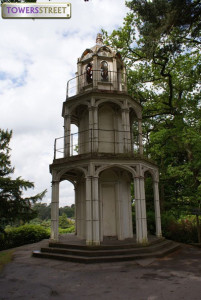 Continuing our descent into the deepest part of the Gardens, one of the most visible structures lies ahead on top of a peak known as ‘Thompson’s Rock’. This is the Gothic Prospect Tower.
Continuing our descent into the deepest part of the Gardens, one of the most visible structures lies ahead on top of a peak known as ‘Thompson’s Rock’. This is the Gothic Prospect Tower.
The Gothic Prospect Tower has stood overlooking the valley since 1824, and presently holds a Grade II listed status. The original architecture featured windows in the design as well as a stunning gold trim that graced the summit of its structure. More recently, park guests were able to climb a dizzying interior spiral staircase to the third floor to witness the unrivalled views of the Gardens and valley, but the state of disrepair that the tower had begun to fall into sadly prohibited this gem of an experience from being available to us today.
Despite the modern generation’s obtrusive addition to the interior of the tower in graffiti, most of the exterior cast ironwork remains intact, albeit painted entirely in white rather than the original colours. Designed again by Robert Abraham as well as Charles Talbot himself, the tower, (which was built an extensive stones throw away over in Derby), could potentially be restored later this year, with planning applications submitted to renovate the structure and hopefully implement the appearance from its golden glory days.
The tower is within close proximity to the Forbidden Valley Skyride station, which leaves us alarmingly close to withdrawing from the unique and picturesque escapism the Gardens provide, so we shall continue on our path now directly south.
The Pagoda Fountain
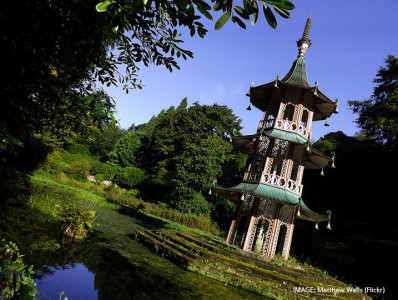 Right in the bowels of the Gardens we can observe the Pagoda Fountain. This beautiful structure dates back to the 1830’s, and stands at 44 foot high. The fountain was another one of the masterpieces designed by Robert Abraham, with inspiration drawn from the To-ho pagoda in Canton, over in the States. Construction on the fountain began originally in 1826, with an original proposal for the structure to consist of a six storey layout as opposed to the three storey version we see today.
Right in the bowels of the Gardens we can observe the Pagoda Fountain. This beautiful structure dates back to the 1830’s, and stands at 44 foot high. The fountain was another one of the masterpieces designed by Robert Abraham, with inspiration drawn from the To-ho pagoda in Canton, over in the States. Construction on the fountain began originally in 1826, with an original proposal for the structure to consist of a six storey layout as opposed to the three storey version we see today.
The fountain has the capability to project its water up to 70ft skywards, coming tantalisingly close to the bottom of the passing overhead Skyride gondolas. Not only is the fountain itself visually impressive, but also the vast lake it resides on. Nature attempts to somewhat reclaim it with a great plethora of pond reeds; although this arguably complements the scene, adding to the beautiful tranquillity this area of the Gardens offer.
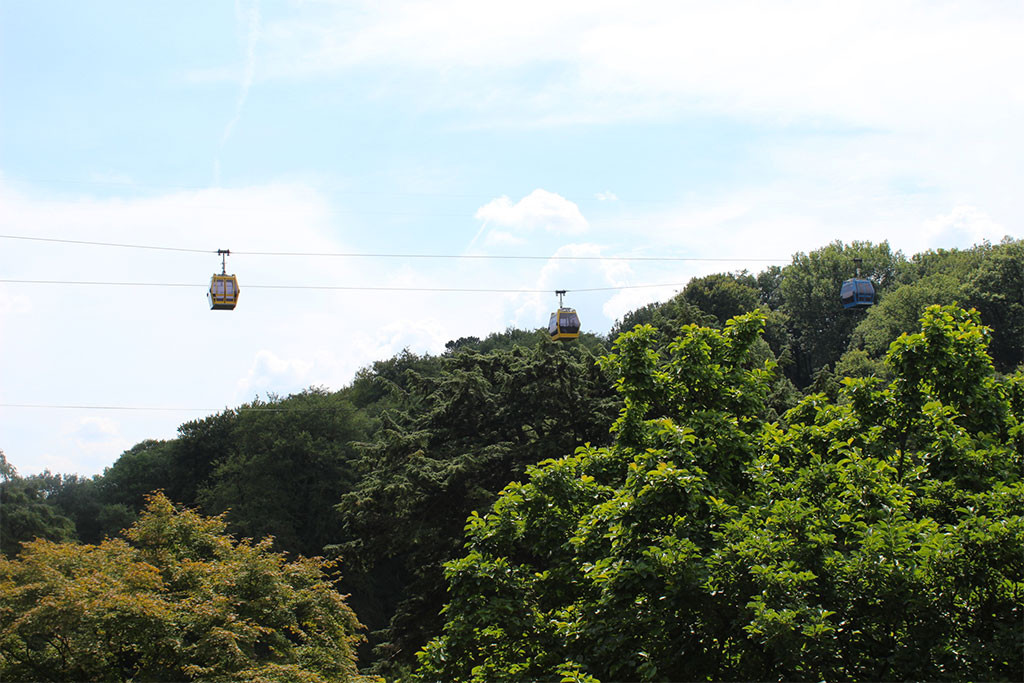 The colourful and modern Skyride gondolas compliment the extensive array of colours on offer in the Gardens below
The colourful and modern Skyride gondolas compliment the extensive array of colours on offer in the Gardens below
Much like the Corkscrew Fountain, the Pagoda Fountain obtains its water source from elsewhere in the Gardens, most notably an area known as the Rock Garden, which we will encounter later on in our tour.
The tour continues in part 2 of Danny’s guide to The Gardens. Danny and TowersStreet would like to thank the following contributors for their images in this article:

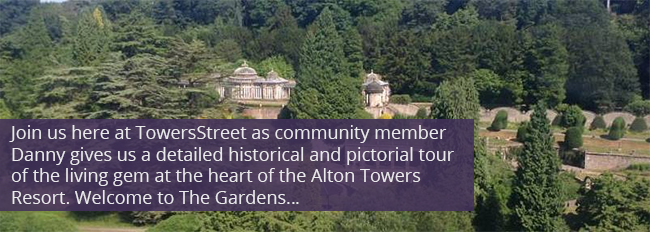
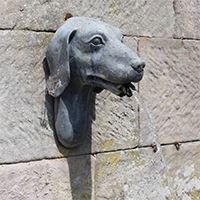
 On my first visit to Alton Towers back in 2000, even the dizzying heights from atop Squirrel Nutty were enough to terrify me. Fast forward to the age of twenty and I've conquered every ride and attraction at the Resort that little Danny would have never dared step foot on.
On my first visit to Alton Towers back in 2000, even the dizzying heights from atop Squirrel Nutty were enough to terrify me. Fast forward to the age of twenty and I've conquered every ride and attraction at the Resort that little Danny would have never dared step foot on.